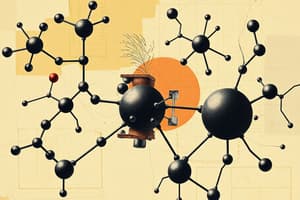Podcast
Questions and Answers
What is the main focus of biochemistry?
What is the main focus of biochemistry?
- Analyzing the atmospheric chemical composition
- Studying the chemical processes in non-living organisms
- Investigating the physical structure of rocks and minerals
- Exploring the chemical processes within living organisms (correct)
Which disciplines does biochemistry combine to understand biological molecules?
Which disciplines does biochemistry combine to understand biological molecules?
- Art, Music, Sociology
- Chemistry, Literature, Mathematics
- Physics, Geology, History
- Chemistry, Biology, Physics (correct)
What are the four major classes of biological macromolecules?
What are the four major classes of biological macromolecules?
- Rocks, Trees, Air, Water
- Metals, Gases, Minerals, Liquids
- Plants, Animals, Fungi, Bacteria
- Carbohydrates, Proteins, Nucleic Acids, Fats (correct)
What is the primary function of carbohydrates in cells?
What is the primary function of carbohydrates in cells?
Which type of macromolecule is responsible for maintaining the structure and function of cells?
Which type of macromolecule is responsible for maintaining the structure and function of cells?
What does biochemistry control through biochemical signaling?
What does biochemistry control through biochemical signaling?
What is the primary function of lipids in cells?
What is the primary function of lipids in cells?
Which of the following is NOT a macromolecule?
Which of the following is NOT a macromolecule?
How many standard amino acids are found in proteins?
How many standard amino acids are found in proteins?
What is the main difference between DNA and RNA?
What is the main difference between DNA and RNA?
What makes carbon unique among elements for forming complex organic molecules?
What makes carbon unique among elements for forming complex organic molecules?
Which functional group determines the acidity of organic molecules?
Which functional group determines the acidity of organic molecules?
Flashcards are hidden until you start studying
Study Notes
The Chemistry of Life: An In-depth Look at Biochemistry, Macromolecules, and Organic Molecules
Introduction
The chemistry of life is a fascinating and complex field that underpins our understanding of living organisms and their processes. This article delves into the intricacies of biochemistry, macromolecules, and organic molecules, exploring how they contribute to the functioning of cells and organisms as a whole.
Biochemistry: The Study of Life's Chemistry
Biochemistry is the study of chemical processes that occur within living organisms. It is a multidisciplinary field that combines principles from chemistry, biology, and physics to understand the composition and behavior of biological molecules. Biochemistry governs all living organisms and living processes, controlling information flow through biochemical signaling and the flow of chemical energy through metabolism.
Macromolecules: The Building Blocks of Life
There are four major classes of biological macromolecules: carbohydrates, lipids, proteins, and nucleic acids. These macromolecules make up the majority of a cell's mass and perform a wide array of functions within cells. They are essential for maintaining the structure and function of cells, as well as for the proper functioning of organisms.
Carbohydrates
Carbohydrates are macromolecules consisting of carbon, hydrogen, and oxygen in a ratio of 1:2:1. They serve as energy sources and structural support in cells. Some common carbohydrates include glucose, fructose, and galactose, which are monosaccharides, and sucrose, lactose, and maltose, which are disaccharides.
Lipids
Lipids are nonpolar and insoluble in water. They serve various roles in cells, including energy storage, cell membrane structure, and as precursors for other molecules. Lipids include triglycerides, phospholipids, and steroids.
Proteins
Proteins are macromolecules made up of amino acids, which are composed of a carboxyl group and an amino group. There are 20 standard amino acids in proteins, and the sequence of these amino acids determines the protein's structure and function.
Nucleic Acids
Nucleic acids, including DNA and RNA, are macromolecules made up of nucleotides, which consist of a pentose sugar, a nitrogenous base, and a phosphate group. DNA carries the hereditary information of the cell, while RNA plays a role in protein synthesis and cellular regulation.
Organic Molecules: The Backbone of Life
Organic molecules are compounds containing carbon and are essential for life. Carbon is unique among elements for its ability to form long chains and rings of carbon atoms, leading to the formation of complex organic molecules found in living organisms.
Carbon Bonding
Carbon contains four electrons in its outer shell, allowing it to form four covalent bonds with other atoms or molecules. The simplest organic carbon molecule is methane (CH4), but carbon atoms can also bond with other elements, such as nitrogen, oxygen, and phosphorus, forming a diverse range of functional groups and molecules.
Functional Groups
Functional groups, such as carboxyl, carbonyl, methyl, and amino groups, give specific functionality to organic molecules, determining their reactivity and behavior within cells.
Conclusion
The chemistry of life is a complex and fascinating field that underpins our understanding of living organisms and their processes. By studying biochemistry, macromolecules, and organic molecules, we can gain insights into the intricate workings of cells and the role that these molecules play in maintaining the structure and function of living organisms.
Studying That Suits You
Use AI to generate personalized quizzes and flashcards to suit your learning preferences.


